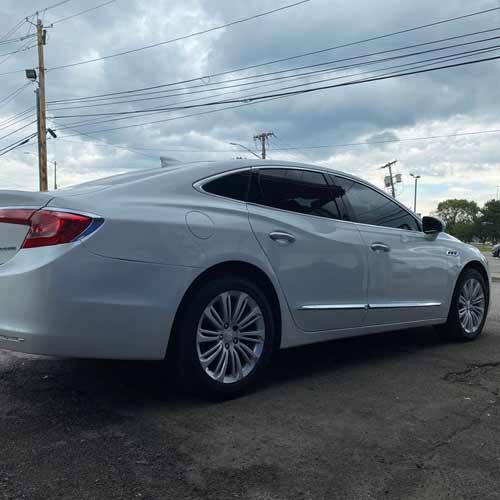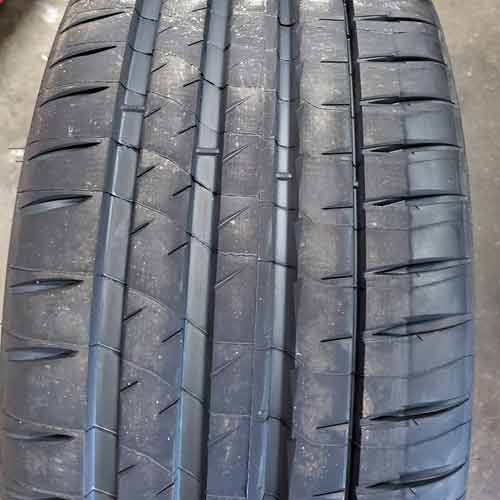Both the Michelin Pilot Sport 5 and the renowned Michelin Pilot Sport 4S are known for their exceptional quality and performance. So, join me as I dissect their features and performance to help you make the best choice!

When choosing between these boys, it’s a matter of honing in on specific preferences. The Michelin Pilot Sport 5 stands out with better resistance to hydroplaning and superior dry braking capabilities, coupled with a longer tread life that promises durability. Additionally, it offers a quieter ride and is more fuel-efficient, adding to the comfort and economy of your drives. Meanwhile, the older Michelin Pilot Sport 4S showcases pronounced excellence in wet conditions, offering better wet braking and handling, and also excels in dry handling, ensuring a firm and responsive grip on the road.
Table of Contents
Tire Sizes
As of now, the Michelin Pilot Sport 4S comes in 222 sizes with following specs.
- Speed ratings: Y only.
- Load ratings: SL and XL.
- Tread depth: 8.5/32″ on all.
- Weight range: 19 to 37 lbs.
- Treadwear warranty: 30k miles.
The Michelin Pilot Sport 5 on the other side comes in 50 sizes with following.
- Speed ratings: Y only.
- Load ratings: SL and XL.
- Tread depth range: 9/32″
- Weight range: 17 to 34 lbs.
- Treadwear warranty: 30k miles.
Tread Design
The Michelin Pilot Sport 4S distinguishes itself with an asymmetric tread pattern that houses a total of five ribs.

Observing the layout closely, you’ll notice that the central three ribs create four longitudinal channels of varying widths, with the right-most groove being the most narrow (see the image).
Underneath these uninterrupted, “continuous-running” ribs, is a secondary layer of rubber that is basically structured for the directional grip, particularly on dry roads.
But yes, these ribs also have a variety of cuts and sipes, positioned at more diverse angles to enhance wet traction substantially.
Moving on, the shoulders on the tire have a more aggressive stance, as they are equipped with solid cuts. These specific groove notches or “cuts”, facilitate the remarkable lateral G-forces, showcasing the tire’s adept handling capabilities.
On the flip side, the Michelin Pilot Sport 5, while sharing certain characteristics with the 4S, takes on a less aggressive approach in its design.

Yes, it embraces the asymmetric tread pattern, and the three central ribs foster similar circumferential channels, but a closer look at the shoulders reveal some marked differences.
The cuts present here are not as prominent, which yes it tells you about the tire’s slightly lacking performance in dry handling compared to the Pilot Sport 4S.
However, it compensates for this with exceptional braking efficiency, a feat achieved through the simplified structure of its central ribs.
Moreover, surrounding this, the other ribs feature a combination of lateral and slanted cuts, which are integral in ensuring dependable wet traction too.
Though note how the siping design is mostly lateral here.
Impact Comfort
The overall comfort on road is significantly influenced by a tire’s ability to absorb road irregularities and imperfections.
That’s why tires crafted with softer materials both internally and at the tread surface usually promise a smoother, more pleasant driving experience.
However, the Michelin Pilot Sport 4S seems to be missing that, as it’s construction is slightly more rigid. Although it offers superior steering response, it makes the ride feel more jittery.
Tread Longevity
The longevity of a tire’s tread is fundamentally influenced by three critical following factors.
- Rolling resistance.
- Tread depth.
- Material composition.
(Tires featuring deeper treads and crafted from sturdier materials generally exhibit slower wear rates, thereby promising extended tread life).
Upon analyzing these aspects, it becomes evident that the Michelin Pilot Sport 5 offers a superior performance in this area.
Its durable rubber composition is more resistant to rapid wear and tear, and its slightly deeper tread depth ensures a prolonged lifespan before attaining the minimum legal tread depth of 2/32 inches.
Side note: Both tires still come with a 30,000-mile warranty.
Dry Performance
Dry traction is two parts, directional grip, and lateral grip. Let’s start with the former.
Directional Grip
Diving into the specifics of longitudinal traction, it can be defined as the ability of a tire to maintain grip on dry and straight pathways.
And straight rolling heavily depends on how well the tire’s rubber from the middle, meets up with the road. As that’s the area which gets the most weight concentration on itself.
In this particular arena, the Michelin Pilot Sport 5 emerges as a standout performer, registering relatively shorter braking distances on an average scale, thereby securing its place as a better performing tire here.
Though keep in mind that the difference between the two tires is pretty marginal.
Dry Handling
Switching the focus to dry handling, it is essential to note that the tire’s lateral stability and maneuverability is largely influenced by the extremities of the tread, aka shoulders, and sidewalls.
Meaning, how well shoulders contact the road is very significant.
This is because as the tire turns/corners, the weight it carries tries to shift towards these shoulder lugs, so they need to make a good enough contact with the surface.
That’s why the Michelin Pilot Sport 4s with greater rubber to road contact offering from its shoulder ribs, get to be better here.
Moreover, with reinforced foundations there, (meaning with continuous running shoulder ribs), you get a firmer lug-to-road interaction which results in superior under and over steering balance.
And consequently, you get a quicker overall steering response and with it faster handling lap times (as seen on tests).
Performance on Wet Surfaces
Wet traction is actually divided in to two parts, resistance to hydroplaning, and wet grip. And both of these are achieved through efficient water cleaning (from the tread).
And that’s where grooves and sipes come in.
Grooves create pathways for the majority of water to leave out, and it defines the main resistance to hydroplaning.
While sipes clear off the remaining left over water particles (which come directly underneath the tread).
These (sipes) are basically tiny slits which create suction, absorbing water particles so the rubber could grip on the relatively dried up surface.
Now out of both, the Michelin Pilot Sport 5 stands out in hydroplaning resistance tests. This is because with relatively greater tread depth, the tire gets to clear out greater volume of water at a given time, showcasing superior performance in both straight and curved aqua tests.
On the other side, the Michelin Pilot Sport 4s gets to offer superior wet grip in comparison, thanks to its more effective siping/biting edges.
Road Noise
When evaluating the acoustic comfort of a ride, a significant contributor is the road noise emanating from the tires.
But how do this noise gets generated in the first place?
Well air is the main culprit here, where air particles get in mostly through the shoulders of the tread and hit the walls around creating “tread noise”.
Having said that, out of both tires, the Michelin Pilot Sport 5 surpasses its counterparts, primarily due to its aerodynamically streamlined lug design and absence of lateral voids.
This basically confines the areas where air particles can collide, substantially reducing noise generation at the source.
Moreover, this tire also integrates an innovative pitch sequencing technology, utilizing variable angles to further lessen the noise produced by the few air particles that find their way inside, guaranteeing a quieter ride.
Fuel Economy
In this category, there is a direct relationship between rolling resistance and fuel efficiency. But what causes this resistance?
Well some of most important factors here are increased weight and softer tread compounds.
Having said that, it makes sense why the Michelin Pilot Sport 4s offers better fuel economy in comparison. The tire offers a sleeker design characterized by an average shallower tread depth, which basically limits the lug movement during navigation.
And with minimal lug movement, more energy is consumed the right way (in to the rolling of the tire).
Moreover, the tire is also lighter, so it puts less pressure on the lugs, minimizing friction coming form lug-ground interaction.
Take Home Points
So both tires have their pros and cons.
When it comes to impact comfort, the Michelin Pilot Sport 5 seems to have a slight edge due to its construction which facilitates smoother rides (though its steering response isn’t that direct).
When looking at tread longevity, the Sport 5 stands out with its durable rubber composition and deeper tread depth, even though both have a 30,000-mile warranty.
Dry performance is a mixed bag, with the Sport 5 offering better directional grip, resulting in shorter average braking distances. However, the Sport 4S shines in dry handling.
And same goes for wet performance factors, where Sport 5 excels in hydroplaning resistance but lacks in grip compared to Pilot Sport 4S.
Lastly, the Sport 4S has the upper hand in fuel economy due to its sleeker design, though needs some improvement in the noise dampening department.
(Though note, that Sport 5 isn’t that great here either).
Which tire for my Tesla model s
Out of these two here? Michelin Pilot Sport 5.
Hi Ozmen,
Which tyre, 4s or 5 for a Mercedes-Benz CL550 Coupe, 5.5L V8 with 255 40 19 Y front and 275 40 19 Y rear.
Thank you, Timothy
I’d go with Michelin Pilot Sport 5.
Thank you Osmen. I appreciate you responding to my question. Take care, Timothy